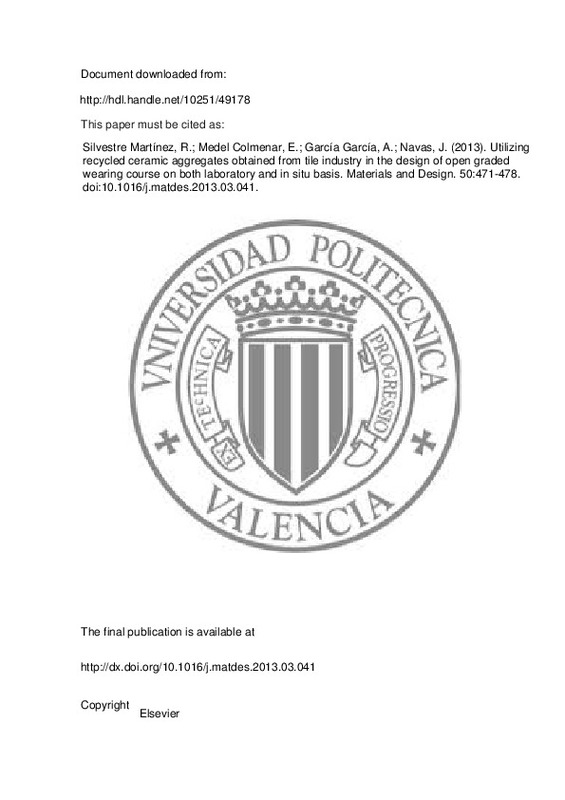JavaScript is disabled for your browser. Some features of this site may not work without it.
Buscar en RiuNet
Listar
Mi cuenta
Estadísticas
Ayuda RiuNet
Admin. UPV
Utilizing recycled ceramic aggregates obtained from tile industry in the design of open graded wearing course on both laboratory and in situ basis
Mostrar el registro sencillo del ítem
Ficheros en el ítem
| dc.contributor.author | Silvestre Martínez, Ramón
|
es_ES |
| dc.contributor.author | Medel Colmenar, Esther
|
es_ES |
| dc.contributor.author | García García, Alfredo
|
es_ES |
| dc.contributor.author | Navas, J.
|
es_ES |
| dc.date.accessioned | 2015-04-23T11:07:15Z | |
| dc.date.available | 2015-04-23T11:07:15Z | |
| dc.date.issued | 2013-09 | |
| dc.identifier.issn | 0261-3069 | |
| dc.identifier.uri | http://hdl.handle.net/10251/49178 | |
| dc.description.abstract | The purpose of the research was to evaluate the technical feasibility of using porcelain and ceramic stoneware tile wastes as aggregate replacement in hot bituminous open graded wearing courses. It is believed that it would reduce the environmental effects of wastes disposal and the natural aggregate demand. The investigated bituminous mix course was an open graded wearing course. Ceramic tile industry wastes were treated to obtain recycled aggregates. These aggregates were characterized and tested to see their suitability to be utilized in bituminous mixtures. The design process of mixture consisted on the study of mixtures prepared with natural and recycled aggregates. The mixtures were produced in both the laboratory and an asphalt plant basis, evaluating the influence of in situ production and scale factors. Recycled ceramic aggregates content was established to obtain appropriate mechanical and superficial characteristics, besides maximizing re-utilization of recycled materials. Up to 30% of recycled ceramic aggregates content by aggregates weight was found to be adequate. However, the partial substitution of natural aggregate by recycled ceramic aggregates involved higher water sensitivity in the mixture. The open graded wearing course with recycled ceramic aggregates was considered to be suitable for medium to low traffic volume roads, though further research is deemed to be necessary for technical and economical viability. (C) 2013 Elsevier Ltd. All rights reserved. | es_ES |
| dc.description.sponsorship | This research would not have been possible without the support of the Research and Development Program of the Institute for Small and Medium Industry from Valencia (IMPIVA, No Exp. IMI-DTF/2011/56), financed by the European Union under the Operational Program of the European Regional Development Fund (ERDF). | en_EN |
| dc.language | Inglés | es_ES |
| dc.publisher | Elsevier | es_ES |
| dc.relation.ispartof | Materials and Design | es_ES |
| dc.rights | Reserva de todos los derechos | es_ES |
| dc.subject.classification | INGENIERIA E INFRAESTRUCTURA DE LOS TRANSPORTES | es_ES |
| dc.title | Utilizing recycled ceramic aggregates obtained from tile industry in the design of open graded wearing course on both laboratory and in situ basis | es_ES |
| dc.type | Artículo | es_ES |
| dc.identifier.doi | 10.1016/j.matdes.2013.03.041 | |
| dc.relation.projectID | info:eu-repo/grantAgreement/IMPIVA//IMIDTF%2F2011%2F56/ES/APROFITAMENT DE RESIDUS CERÀMICS EN MBC COM A SUBSTITUTIU PARCIAL D’ÀRIDS NATURALS, D’ORIGEN CALCARI EN CAPES DE BASE I INTERMÈDIES, I DELS ÀRIDS D’ORIGEN SILÍCI EN CAPES DE RODAMENT/ | es_ES |
| dc.rights.accessRights | Abierto | es_ES |
| dc.contributor.affiliation | Universitat Politècnica de València. Instituto del Transporte y Territorio - Institut del Transport i Territori | es_ES |
| dc.contributor.affiliation | Universitat Politècnica de València. Departamento de Ingeniería e Infraestructura de los Transportes - Departament d'Enginyeria i Infraestructura dels Transports | es_ES |
| dc.description.bibliographicCitation | Silvestre Martínez, R.; Medel Colmenar, E.; García García, A.; Navas, J. (2013). Utilizing recycled ceramic aggregates obtained from tile industry in the design of open graded wearing course on both laboratory and in situ basis. Materials and Design. 50:471-478. https://doi.org/10.1016/j.matdes.2013.03.041 | es_ES |
| dc.description.accrualMethod | S | es_ES |
| dc.relation.publisherversion | http://dx.doi.org/10.1016/j.matdes.2013.03.041 | es_ES |
| dc.description.upvformatpinicio | 471 | es_ES |
| dc.description.upvformatpfin | 478 | es_ES |
| dc.type.version | info:eu-repo/semantics/publishedVersion | es_ES |
| dc.description.volume | 50 | es_ES |
| dc.relation.senia | 251750 | |
| dc.contributor.funder | Instituto de la Pequeña y Mediana Industria de la Generalitat Valenciana | es_ES |
| dc.contributor.funder | European Regional Development Fund | es_ES |







![[Cerrado]](/themes/UPV/images/candado.png)

